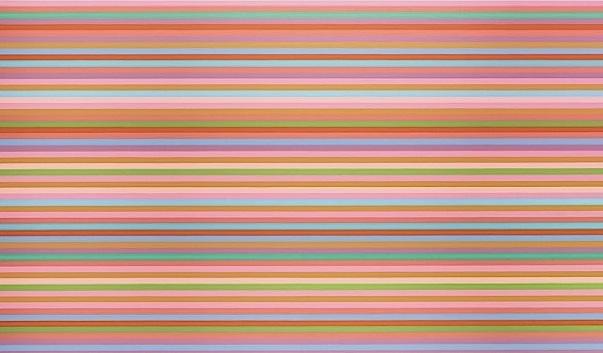Bridget Riley’s exhibition at David Zwirner offers a comprehensive overview of her latest body of work together with preparatory studies, works on paper and earlier stripe paintings ranging from 1961 to 2014. Her career now spanning over more than fifty years has seen no interruption in the exploration of the influence of colour and form on human perception.
Sensory perception is bound to Riley’s art. She explains that the use of material art such as painting offers the pursuit of another medium: perception.
In the first room ‘Prairie’ (2003/1971), a diptych made of continuous inclined stripes, invites the viewer to an active contemplation. The beholder participates to a dynamic visual experience. It is almost impossible to decide on the lines’ orientation: are they inclined to the right or to the left? Because of then blurred effect they create, the exact similarity of both panels is put into doubt as well.
On the third floor the experience repeats itself with earlier works on display. Compared to ‘Prairie’, ‘Late Morning I’ (1967) is an even stronger demonstration of a ‘dynamic’ composition. The flat surface animates itself when one looks at the painting. Staring too long causes discomfort.
A long-standing practice has allowed Riley to understand how colours interact. This pursuit started in the early sixties with her black and white paintings, one also on view in the exhibition. These are the first experiments in generating strong optical effects. Riley however, refuses to be labelled as an optical artist solely. The artist says she has learned more from her practice than from art books even though she is familiar with old masters – especially great colourists such as Titian and Veronese. Sharing Seurat and Matisse’s obsession of decomposing form and colour to achieve a harmonious composition, she acknowledges the Impressionists as inspirational mentors.
Her way of working is intuitive; the experiential is preferred to the merely conceptual. Each hue is created to respond to the tone it superposes. ‘I want to create a colour-form, not coloured forms’ she says in an interview with Richard Shiff. Sequences and variations in colour, intensity and form come into interplay. The slightest alteration in how stripes are set next to each other can change the overall impression of the composition radically.
Riley has stopped painting herself but is still actively involved in the process of making of her works. The drawings hanging on the third flour attest of the meticulous preparation of each work. No computers are used to facilitate the perfection of the designs. Also the flawless finish of the works is achieved manually. A team of assistants coat the canvases carefully with layers of colour.
A great part of her inspiration is drawn from nature, as acknowledged in some paintings’ titles such as ‘Late Morning’ (1969) and ‘Rise I’ (1968). The pale hues recall the soft characteristic light of crisp summer day mornings’. In the exhibition, paintings with plain mineral tones are characteristic of works recalling a journey to Egypt that has informed the ‘Egyptian palette’ Riley developed in the 1980s. In these works the stripes are vertical.
In contrast, her recent body of work is immediately painted over with thick horizontal lines. Their weight and intensity change slightly according to a chromatic rhythm. The ratio is intuitive. This is characteristic to Riley’s work where sensation prevails to theory.
The stripe paintings may seem repetitive to an uneducated eye but Riley has always been able to reinvent herself. As shown across the many works of the exhibition, the sense of participation has remained a constant across her career. Her latest body of work may be her most mature achievement to this day. The vibrant, large-scale compositions celebrate earlier developments with a minimum of means. The canvases give out a solar creative energy. Riley never stops working. Whatever her age, her career is far from over yet.
Words: Amélie Timmermans © Artlyst 2014 Image: Arioso (Blue), 2013 Courtesy The Artist and David Zwirner Gallery

